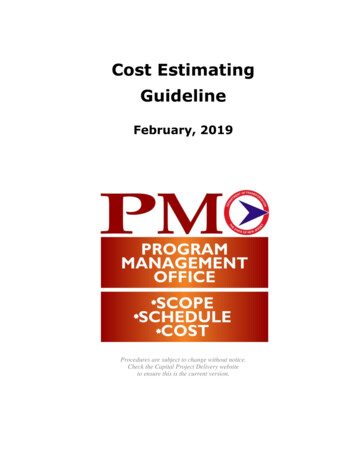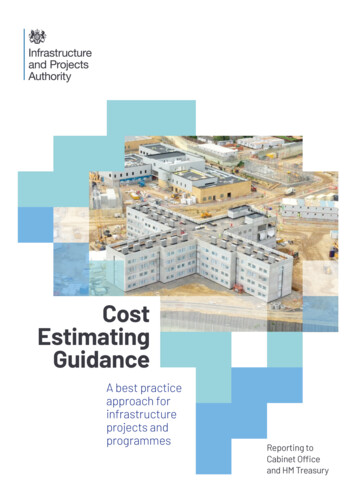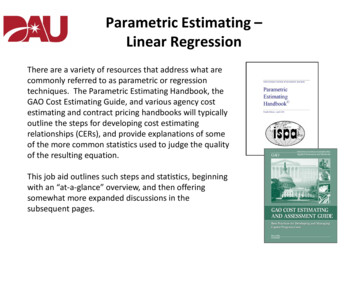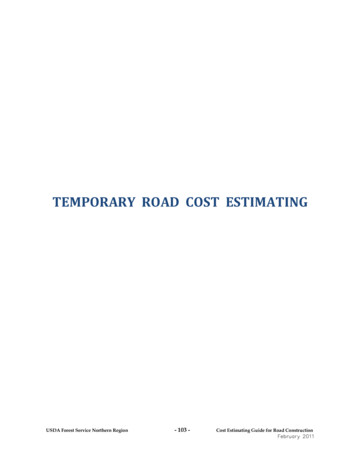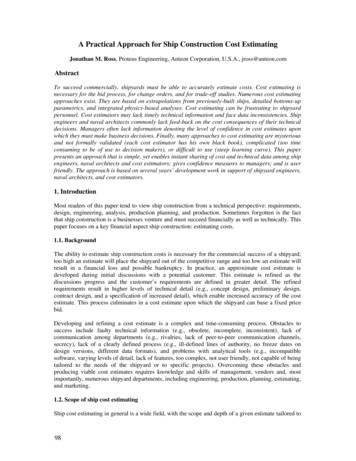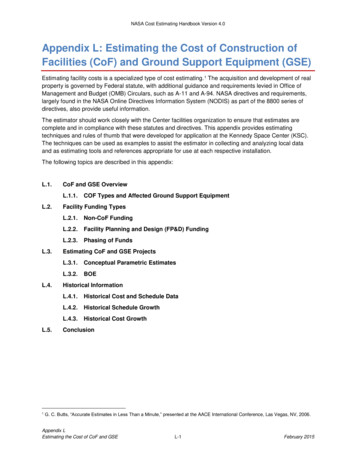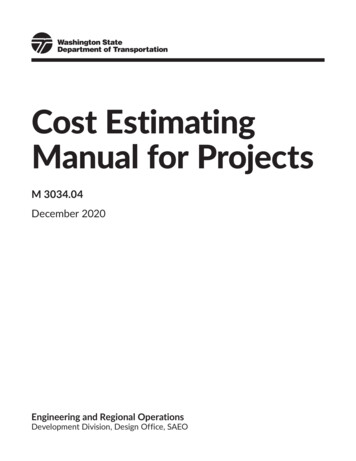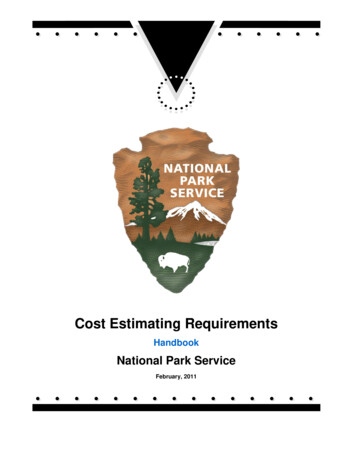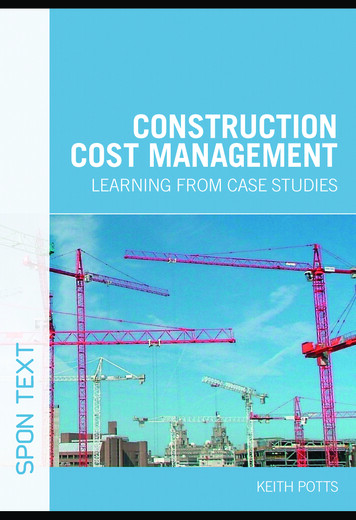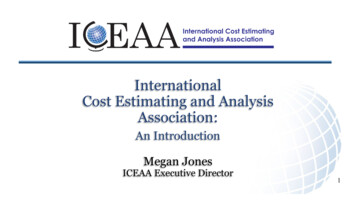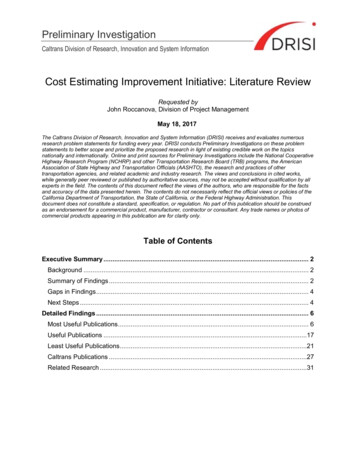
Transcription
Preliminary InvestigationCaltrans Division of Research, Innovation and System InformationCost Estimating Improvement Initiative: Literature ReviewRequested byJohn Roccanova, Division of Project ManagementMay 18, 2017The Caltrans Division of Research, Innovation and System Information (DRISI) receives and evaluates numerousresearch problem statements for funding every year. DRISI conducts Preliminary Investigations on these problemstatements to better scope and prioritize the proposed research in light of existing credible work on the topicsnationally and internationally. Online and print sources for Preliminary Investigations include the National CooperativeHighway Research Program (NCHRP) and other Transportation Research Board (TRB) programs, the AmericanAssociation of State Highway and Transportation Officials (AASHTO), the research and practices of othertransportation agencies, and related academic and industry research. The views and conclusions in cited works,while generally peer reviewed or published by authoritative sources, may not be accepted without qualification by allexperts in the field. The contents of this document reflect the views of the authors, who are responsible for the factsand accuracy of the data presented herein. The contents do not necessarily reflect the official views or policies of theCalifornia Department of Transportation, the State of California, or the Federal Highway Administration. Thisdocument does not constitute a standard, specification, or regulation. No part of this publication should be construedas an endorsement for a commercial product, manufacturer, contractor or consultant. Any trade names or photos ofcommercial products appearing in this publication are for clarity only.Table of ContentsExecutive Summary . 2Background . 2Summary of Findings . 2Gaps in Findings . 4Next Steps . 4Detailed Findings . 6Most Useful Publications . 6Useful Publications .17Least Useful Publications .21Caltrans Publications .27Related Research .31
Executive SummaryBackgroundCaltrans has assembled a team to investigate best practices for cost estimating, includingimproved methods for determining both capital and support costs. Capital costs include thecosts of construction, and support costs include preconstruction costs for such tasks as designand surveying, as well as maintenance costs throughout the life cycle of a facility. Developingbetter methods of cost estimating is essential to Caltrans’ goal of addressing the needs of itspartners, including the California Legislature, Federal Highway Administration (FHWA), theCalifornia Transportation Commission, local agencies and taxpayers.To assist in this effort, CTC & Associates conducted a review of literature provided by Caltranson best practices for cost estimation and management. A second phase of this project willinvolve a survey of the 12 Caltrans districts that examines the districts’ cost estimating methods.Summary of FindingsCTC & Associates conducted a literature review of publications provided by Caltrans. Thepublications were divided into categories based on an assessment of their level of usefulness toCaltrans: Most Useful Publications: Publications selected for this category include detailed andspecific information relevant to cost estimation and management. Useful Publications: These publications are on point but not as important as those inthe first category. Least Useful Publications: These publications may be relevant but often contain onlyvery general information or information that is less directly related to cost estimation andmanagement than those publications in the previous categories. Caltrans Publications: These documents are studies or presentations conducted withinCaltrans. While the information on cost estimation and management is typically verygeneral, it is important to Caltrans’ efforts.Each of these categories is further subdivided as necessary into the following topics: Cost Estimation and Management. Risk Management. Project Management. Financing. Staffing.CTC & Associates also conducted a search for recent literature on cost estimation andmanagement as well as risk management. Links and abstracts for these resources are providedin Related Research.Highlighted below are publications provided by Caltrans and found during the literature search.The publications are grouped by topical categories.Produced by CTC & Associates LLC2
Cost Estimation and Management NCHRP Report 826 presents a framework for developing data-driven preconstructionservices (PCS) cost estimating models for highway projects. The framework can beimplemented with standard spreadsheet and database software. AASHTO’s Practical Guide to Cost Estimating covers conceptual (parametric)estimating, historical bid-based estimating, cost-based estimating and risk-basedestimating. Tables 1-2 and 1-3 show how each of these estimate types can be applied todifferent phases of project development. Chapters devoted to each type of estimatinggive detailed accounts of the steps involved (including, for example, databaserequirements and construction cost factors for conceptual estimating). NCHRP Report 574 details processes for cost estimation and management. Seeespecially Figure 2.2 for an agency-level flowchart for cost estimation practice and costestimation management, and Tables 2.2 and 2.3 for details of the cost estimation andmanagement processes. NCHRP Report 625 provides an equally detailed breakdown ofprocesses for right of way (ROW) cost estimation and management. Also useful is the Project Management Institute’s Practice Standard for ProjectEstimating. More general in its guidance is FHWA’s Major Project Program CostEstimating Guidance, which is geared toward cost estimates for projects seeking federalfinancial assistance. Caltrans’ FY 2015-16 Fourth Quarter Project Delivery Report includes several slides oncost estimating, including bulleted lists of best practices, causes of bad estimates, tipsfor success and ideas to improve estimating. Other Caltrans documents provide reasonsfor changes in the scope of Caltrans projects; a list of cost estimating tools andtechniques; background information on the State Highway Operation and ProtectionProgram (SHOPP); ideas for managing risk; and a list of project financing challenges. A review of related research found an ongoing project to develop a proceduralguidebook and software tool to enhance the accuracy of cost estimates and projectscheduling for Texas metropolitan planning organizations (MPOs). Information aboutseveral other recent studies on cost estimation and management was also found.Risk Management NCHRP Report 658 describes an iterative risk management framework that can be usedfor both small and large projects. The framework has five steps: risk identification, riskassessment/analysis, risk mitigation and planning, risk allocation, and risk monitoringand control. Guides from several state departments of transportation (DOTs) provide very usefulinformation on risk management:oWashington State DOT has developed a spreadsheet tool for performing MonteCarlo simulations. An accompanying guide explains how to use this tool toidentify and quantify project risks and their influence on project cost andschedule, and to monitor and manage those risks. A Washington State DOTpolicy letter gives step-by-step procedures for reporting risk-based estimates inits Capital Program Management System (CPMS).Produced by CTC & Associates LLC3
oGeorgia DOT has developed a software tool “specifically designed foridentification and qualitative assessment of highway project risks during the preconstruction phase of the project.” A comprehensive guidebook for risk analysisaccompanies the software tool.oNevada DOT’s Risk Management and Risk-Based Estimation Guidelinesincludes detailed, useful information on processes for risk management and costestimation. Also useful are an FHWA report on transportation risk management, which includes afive-step process of risk identification, analysis, evaluation, treatment and monitoring; theProject Management Institute’s Practice Standard for Project Risk Management, which“provides a benchmark for the project management profession that defines the aspectsof Project Risk Management that are recognized as good practice on most projects mostof the time”; and an Oregon DOT case study on managing risk, which applies anassessment tool developed as part of the second Strategic Highway Research Program(SHRP 2). Less directly useful are an article on the neurological and procedural root causes of“overly optimistic estimates” and an NCHRP report with very general recommendationsregarding risk management for state DOTs. A review of related research found a recent case study of risk-based estimatingpractices by Minnesota DOT, as well as several other studies on risk management.Project Management NCHRP Project 20-68A, Scan 7-01, Best Practices in Project Delivery Management,cites Washington State DOT’s project management practices and the way the agencymanages risk. Also useful is NCHRP Report 821, which “illustrates the effort needed to develop arobust cost estimate and then manage to a baseline budget and scope throughout theproject delivery cycle”; and the Project Management Institute’s Guide to ProjectManagement Body of Knowledge, which is the “global standard for projectmanagement.” More general in their guidance are FHWA’s Guide to Project Management Strategies forComplex Projects, which outlines a five dimensional project management approach forcomplex projects, and several other FHWA and NCHRP project management guides.Gaps in FindingsBecause of the large number of resources provided by Caltrans for review, CTC was able toprovide only a cursory overview of recent research related to cost estimation and managementnot included in Caltrans’ list, and has included only the abstracts of these studies.Next StepsIn Phase II of this Preliminary Investigation, CTC will conduct a survey of the 12 Caltransdistricts that examines the districts’ cost estimating methods. Each of the 12 Caltrans districtswill receive surveys targeted at all nine functional units within each district. After completion ofProduced by CTC & Associates LLC4
Phases I and II, Caltrans may require a third phase of research that includes a second round ofsurveys.Using the results of this Preliminary Investigation, Caltrans will develop the support and capitalcost estimating and management method improvements necessary for addressing the needs ofits partners.Produced by CTC & Associates LLC5
Detailed FindingsMost Useful PublicationsCost Estimation and ManagementEstimating Highway Preconstruction Services Costs—Volume 1: Guidebook, NCHRPReport 826, s guide presents a framework for the development of data-driven PCS cost estimatingmodels for highway projects. It can be implemented with standard spreadsheet and databasesoftware as a means for agencies to estimate, at an early stage of project development, howmuch it will cost to plan, program, permit and design a project. Topics range from the principalsources of PCS costs at various stages of project development to PCS cost estimatingmethodologies and external trends likely to influence costs.From page 10:This guidebook describes the step-by-step process to develop a top-down PCS costestimating model with three different data-driven approaches: Multiple regression modeling. Decision tree analysis. Artificial neural network modeling.Summaries of each chapter follow:Chapter 2: PCS Cost-Estimating Process. “This chapter describes the overall PCS costestimating process that is aligned with a typical project development process. The need forthree different approaches for estimating PCS costs is explained. The appropriate timing ofapplication and the effectiveness of use are discussed” (page 10). See Figure 2.3 (page 14)for a diagram of the PCS cost-estimating process, and pages 18-19 for information aboutdeveloping a data-driven model.Chapter 3: PCS Database Development and Management. “This chapter discusses adatabase development and management process required for a successful implementationof data-driven PCS cost estimating. Some specific topics discussed in this chapter are datacollection and cleaning strategies, identification and evaluation of potential input variables,and development/optimization of PCS databases” (page 10). See Table 3.1 (pages 22-23)for factors affecting PCS costs.Chapter 4: Top-Down PCS Cost Estimating. “This chapter explains the developmentprocess of top-down PCS cost-estimating models. Three data-driven methods are discussedin detail: multiple regression, decision trees, and artificial neural networks” (page 10).Chapter 5: Functional-Level PCS Cost Estimating. “This chapter discusses the developmentprocess of functional-level PCS cost-estimating models. It also discusses the use of a workbreakdown structure in developing a functional-level PCS cost-estimating model, discussesProduced by CTC & Associates LLC6
the feedback loop for continuous improvement, and addresses issues in database creation,maintenance, and management” (page 10).Chapter 6: Implementing PCS Cost-Estimating Models. “This chapter discusses importantaspects related to the implementation of PCS cost-estimating models in practice, such asthe interpretation of PCS cost estimates, incorporation of these estimates into decisionmaking procedures, tracking of PCS costs throughout the project development process,capturing lessons learned from the use of the framework described in this guidebook andspecific models developed by using it, and continuous improvement procedures to optimizethe performance of these models” (page 11).Chapter 7: Project-Specific PCS Estimating Issues and Contract Administration Guidance.“This chapter discusses project-specific and contract administration issues associated withthe development and use of PCS cost-estimating models. The chapter covers projectmonitoring strategies, actions required under potential scope changes, how to use the PCScost estimate to identify and quantify scope creep, and some aspects related to the use ofin-house versus external designers/consultants” (page 11).Practical Guide to Cost Estimating, 1st edition, American Association of State Highway andTransportation Officials, on detail.aspx?ID 122From the summary:Part I of the guide covers the following cost estimating techniques: Conceptual or parametric estimating techniques are primarily used to supportdevelopment of planning or early scoping phase estimates when minimal projectdefinition is available. Statistical relationships or non-statistical ratios, or both,between historical data and other project parameters are used to calculate the costof various items of work (i.e., center lane miles or square foot of bridge deck area). Historical bid-based estimating relies heavily on element or bid items, or both, withquantities and good historical bid data for determining item cost. The historical datanormally is based on bids from recent projects. The estimator must adjust thehistorical data to fit the current project characteristics and location. The historicaldata must also be adjusted to reflect current dollars. With the use of historical biddata, estimators can easily and quickly prepare estimates. Cost-based estimating considers seven basic elements: time, equipment, labor,subcontractor, material, overhead, and profit. Generally, a work statement and set ofdrawings or specifications are used to “take off” material quantities required for eachdiscrete work task necessary to accomplish the project bid items. From thesequantities, direct labor, materials, and equipment costs are calculated based oncalculated or assumed production rates. Contractor overhead and profit are thenadded to this direct cost. Risk-based estimating combines (1) traditional estimating methods for known itemsand quantities with (2) risk analysis techniques to estimate uncertain items, uncertainquantities, and risk events. The risk-based portion of the estimate typically focuseson a few key elements of uncertainty and combines Monte Carlo sampling andheuristics (rules of thumb) to rank critical risk elements. This approach is used toestablish the range of total project cost and to define how contingency should beallocated to critical project elements.Produced by CTC & Associates LLC7
Tables 1-2 and 1-3 (pages 21-22) provide information about the different types of costestimating required at different phases of the project development process:Chapter 2, “Conceptual Estimating,” presents key inputs to estimates, including good historicalcost data and project-related information matched to cost data (page 29), and databaserequirements (page 30). Section 2.2.3.1 provides construction cost factors, including lane-milecost factors, bridge cost factors and preliminary engineering. The chapter gives an example ofusing a computer-based conceptual estimating tool, TRACER, to output “quantities for variousitems of work, unit prices, and calculations to derive a construction base cost estimate” (page42).Produced by CTC & Associates LLC8
Section 2.7 provides project examples, and Table 2-9 (page 56) gives an example of aconceptual cost estimate:Chapters 3 through 5 give similarly detailed accounts of methods for conducting bid-based,cost-based and risk-based estimates. Part II of the guide covers the following cost managementtopics: Inflationary considerations. Letting strategies for cost control. Analysis of contractor bids. Performance measures for cost estimating.Procedures Guide for Right-of-Way Cost Estimation and Cost Management, NCHRPReport 625, s guide presents a five-step, structured approach to ROW cost estimation and costmanagement (page 3):1. Determine ROW estimate basis.2. Prepare ROW base estimate.3. Determine ROW risk and set contingency.4. Review ROW cost estimate.5. Approve and communicate ROW cost estimate.Produced by CTC & Associates LLC9
The guide describes four “distinct but interrelated ROW cost estimating and cost estimatingmanagement processes” (pages 3-4): Conceptual ROW Cost Estimating, which occurs during the Planning phase of projectdevelopment and supports SHA [state highway agency] long-range plans; generally thisphase is where the first estimate is prepared for a project. Baseline ROW Cost Estimating, which occurs during the Programming phase ofproject development and supports intermediate plans (10 years or less). Several costestimates may be prepared before the final estimate of this phase, based on thepreferred project alternative, is used to set a Total Project Baseline Estimate. The TotalProject Baseline Estimate is often used to move a project into the State TransportationImprovement Program (STIP). The ROW portion of the Total Project Cost Estimate thenbecomes the ROW budget amount for the project. Management will use this BaselineROW Cost Estimate to monitor the cost impact of future ROW estimates prepared inresponse to development of the project design. Updated ROW Cost Estimates are prepared during the Preliminary Design phase ofproject development and involve updating estimated ROW cost as designs are preparedleading to the final ROW plans. Updated estimates are reconciled with the Total ProjectCost Estimate to help in managing ROW cost and its contribution to total project cost. ROW Cost Management occurs when the appraisal and acquisition process begins andcontinues throughout Final Design activities. Actual ROW expenditures are captured andused to forecast total ROW costs. Management is constantly comparing forecastedROW cost as compared with the updated ROW budget.Chapter 2 presents an integrated estimating process and cites the four-step cost estimatingprocess described in NCHRP Report 574 (see citation below). Remaining Chapters 4 through 6give detailed steps for developing ROW conceptual, baseline, and updated ROW costestimates, and Chapter 7 provides information about ROW cost management.Guidance for Cost Estimation and Management for Highway Projects During Planning,Programming and Preconstruction, NCHRP Report 574, .aspxThis report provides an overview of cost estimation for highway projects and is cited by manyother reports in this Preliminary Investigation.The following figures and tables in Chapter 2, “Agency Cost Estimation Practice and CostEstimation Management Processes,” are especially useful: Figure 2.1 (page 8) details development phases and activities. Figure 2.2 (page 9) provides an agency-level flowchart for cost estimation practice andmanagement. Table 2.2 (page 11) details the cost estimation process, and Table 2.3 (page 12)describes the cost estimation management process.Other chapters detail: Cost escalation factors, such as project schedule changes and scope creep, andstrategies to address them (Chapter 3).Produced by CTC & Associates LLC10
A guide for the planning phase of projects (Chapter 5). Figure 5.1 (page 23) presents anoverview of cost estimation practice and management. The chapter also covers budgetcontrol and risk analysis; Table 5.10 (page 38) lists methods and tools presented in thechapter for use in planning. A guide for the programming and preliminary design phase (Chapter 6) and for the finaldesign phase (Chapter 7).The report identifies the following keys to cost estimation success (page 2):Cost estimation management:1. Make estimation a priority by allocating time and staff resources.2. Set a project baseline cost estimate during programming or early in preliminarydesign, and manage to this estimate throughout project development.3. Create cost containment mechanisms for timely decision making that indicate whenprojects deviate from the baseline.4. Create estimate transparency with disciplined communication of the uncertainty andimportance of an estimate.5. Protect estimators from internal and external pressures to provide low costestimates.Cost estimation practice:1. Complete every step in the estimation process during all phases of projectdevelopment.2. Document estimate basis, assumptions, and back-up calculations thoroughly.3. Identify project risks and uncertainties early, and use these explicitly identified risksto establish appropriate contingencies.4. Anticipate external cost influences and incorporate them into the estimate.5. Perform estimate reviews to confirm that the estimate is accurate and fully reflectsproject scope.Risk ManagementRisk Based Estimate Self-Modeling, Washington State Department of Transportation,September 2016.See Appendix A (guide) and Appendix B (spreadsheet tool).Washington State DOT developed a spreadsheet tool for performing Monte Carlo simulations,“a powerful mathematical process widely used to conduct quantitative risk analysis. Thissimulation runs thousands of scenarios of each risk realization while factoring combinations ofcost and schedule inputs, risk probabilities and impacts.” The guide explains how to use the toolto assist in “identifying and quantifying project risks and their influence on cost and schedule ofthe project,” and “to monitor and manage those risks” (page 7). The tool includes worksheets fordata input and output that provide visualizations of the impacts of risks on project costs duringvarious project phases. The worksheets provide “a risk register to facilitate prioritization,monitoring and management of these risks.”Produced by CTC & Associates LLC11
Related Resource:Use of Risk-Based Project Estimates for Budgeting and Project Management,Instructional Letter IL 4071.02, Washington State Department of Transportation, February2012.See Appendix C.From the introduction (page 1):The purpose of this Instructional Letter is to provide Washington State Department ofTransportation (WSDOT) project management staff with information necessary for theuse of risk-based estimating on projects over 10 million, and to require that all projectsregardless of cost shall have a risk matrix to support any established risk reserves.The letter establishes rules and procedures for the use and reporting of risk-basedestimating results (pages 2-3):1. Establish a baseline cost estimate.2. Establish the 60th percentile cost estimate.3. Establish a risk reserve (the difference between (1) and (2)).4. Evaluate the estimate every six months or sooner under certain circumstances.5. Update the estimate, if warranted.6. Assess possibilities for mitigation of risk and include them within the project plan.7. Enter uninflated base cost and risk reserve estimates in the CPMS.8. Manage the base cost estimate.9. Use and adjust the risk reserve, if needed.See pages 4-5 for documentation and information to support estimates.Streamlining Project Delivery Through Risk Analysis, Georgia Department ofTransportation, 05.pdfThis study reviewed practices at other state DOTs to develop “a comprehensive guidebook thatadvances the adoption of risk analysis tools in GDOT [Georgia Department of Transportation],in order to expedite project delivery” (page 9).From pages 9-10:The results indicate that typically state DOTs determine the level and methods of riskmanagement based on project size (i.e. dollar value) and complexity of the project. The levelof risk management may vary from a simple risk register to a complex quantitative analysis.Moreover, several factors such as lack of training of personnel, lack of sufficient internalinfrastructure such as database, lack of existing policies, and lack of risk culture are amongthe most important challenges and barriers to implement a successful risk managementprogram. After reviewing the literature and current risk management practices by stateDOTs, a semi-structured interview was conducted with nine subject matter experts atGDOT.Produced by CTC & Associates LLC12
Researchers used the results to develop a software tool (page 2):Finally, a software tool specifically designed for identification and qualitative assessment ofhighway project risks during the pre-construction phase of the project was developed basedon the shortlisted risk factors. The software program is equipped with the modificationcapability of adding new risk items and/or removing some of the predetermined risk factorsfrom the assessment.Chapter 5 is the manual for the software tool, called Comprehensive Risk Assessment forTransportation (CRAFT), which is “specifically designed for identification and qualitativeassessment of highway project risks during the preconstruction phase of the project.”Risk Management and Risk-Based Cost Estimation Guidelines, Nevada Department ofTransportation, August d 4518This manual provides “guidance to NDOT [Nevada Department of Transportation] personneland consultants in best practice methods of risk management and risk-based cost estimation”(page i). It includes detailed, useful information on processes for risk management and costestimation. Table 1 (page 4) provides a suggested risk management process based on projectsize. Chapter 2 gives a step-by-step process for cost estimation, including determining anestimate basis, preparing a base cost estimate, reviewing the base cost estimate anddetermining risks. Subsequent chapters break down these steps further.Related Resource:Project Cost Estimation Manual, Nevada Department of Transportation, November d 1539This manual provides “guidance and instruction to Roadway Designers, Senior Designersand Project Managers for efficiently and consistently developing project cost estimates inthe integrated Project Development (iPD) system” (page 5). iPD is Nevada DOT’s softwarefor developing cost estimates for contracts.Guidebook on Risk Analysis Tools and Management Practices to Control TransportationProject Costs, NCHRP Report 658, .aspxThis guidebook “provides guidance to state departments of transportation for using specific,practical, and risk-related management practices and analysis tools for managing andcontrolling transportation project costs” (page 5). It describes an “iterative risk managementframework” with five steps that can be used for both small and large projects:1. Risk identification is the process of determining which risks might affect the project anddocumenting their characteristics using such tools as brainstorming and checklists.2. Risk assessment/analysis involves the quantitative or quali
May 18, 2017 · This guide presents a framework for the development of data-driven PCS cost estimating models for highway projects. It can be implemented with standard spreadsheet and database software as a means for agencies to estimate, at an early stage of project development, how much it will cos
